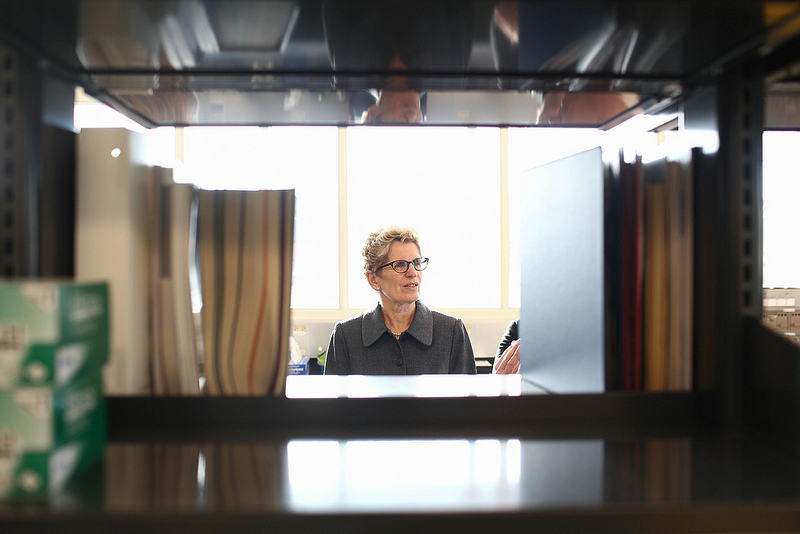After a series of requests from Kathleen Wynne, Prime Minister Stephen Harper finally agreed to meet the Ontario premier this week for a 30-45 minute meeting at the Royal York Hotel in Toronto just prior to a hockey game. The last time the prime minister met with the premier of the country’s most populous province was 13 months ago.
The Toronto Star reports, “Infrastructure funding — particularly for northern Ontario’s Ring of Fire — was on the agenda, as well as the drinking water available to First Nations.” The Globe and Mail explains, “The province wants Ottawa to contribute $1-billion for a road or rail line to the Ring of Fire mineral deposit…”
On first glance, the part about the prime minister and premier discussing drinking water for First Nations could seem like a step forward. The crisis is clear enough. Late last year, CBC reported, “Nearly half of the 133 First Nations in Ontario currently have boil water advisories, and it has been more than ten years since ten First Nations in northwestern Ontario had clean drinking water.”
But it’s also possible — and appears to be the case — that this issue was discussed in the context of the 350-kilometre transportation corridor needed to ship ore out of the Ring of Fire area for processing. In 2012, the Globe and Mail noted, “Ironically, a road of some sort may help with Marten Falls [First Nation’s] short-term drinking-water concerns. …[It] would be ready access to the community, bringing in cheaper supplies and professional help that Marten Falls requires frequently to keep its water system in good shape.”
The “ironic” part is that along with the water contamination risks of extracting $30-billion worth of chromite over a 5,000-kilometre area of pristine wilderness, which would include tailings ponds for the mining waste and hydro-electric dams to power the operations, the road would go through boreal forest and over several major waterways posing further water risks in the traditional lands of the Marten Falls, Webequie, Neskantaga and other First Nations. The Neskantaga First Nation has been without potable water since 1995.
So, did Harper and Wynne discuss access to water for First Nations only in the context of advancing a water-destructive mining agenda?
Additionally, a statement from the Prime Minister’s Office (issued within a half hour of the meeting) says Harper and Wynne “agreed on the importance of ongoing investments in infrastructure, including the federal government’s new Building Canada Fund. They also discussed the need to remove barriers to internal trade, the importance of continued support from both levels of government for the manufacturing and automotive sectors, as well as the important role of resource development for the Ontario and Canadian economies.”
It’s not clear from this statement if Harper and Wynne talked about the investor-state dispute settlement provision that could be part of an “internal trade” deal, or for that matter the estimated $1 billion in increased costs to the province for pharmaceutical drugs given the patent provisions Harper agreed to in the Canada-European Union “free trade” agreement. Nor is it clear when they discussed resource development if the 1.1 million barrel per day Energy East tar sands pipeline through Ontario was mentioned.
It’s also not known if when the conversation turned to the Building Canada Fund, a federal fund that promotes privatization through public-private partnerships, if the Auditor General’s report that revealed P3 projects had cost the people of Ontario $8 billion in extra costs was remembered. Likely not, given that the Globe and Mail notes, “Ms. Wynne has indicated she will play ball with the federal government on infrastructure, submitting several requests for project funding to the Building Canada Fund.” Might those P3 requests include water and wastewater infrastructure?
The Toronto Star notes that the meeting likely happened because, “With Harper headed into a federal election on or before Oct. 19 — and his Conservatives dependent on holding scores of Ontario seats to retain government — he consented to see Wynne.” The Globe and Mail adds that with the election, “Mr. Harper seems determined to defuse potential controversies. Hours before his confab with Ms. Wynne, he also demoted embattled cabinet minister Julian Fantino.”
Maclean‘s magazine more fully notes, “In the 2011 federal election, there were 951,156 more Ontario voters who voted for the Harper Conservatives than there were Ontario voters who voted for the Hudak Conservatives in the 2014 Ontario election. That’s not quite a million Ontario voters who didn’t vote for Hudak, but whom Harper needs to vote for him if he’s to hold his majority. That’s what political moderation looks like. Harper needs the votes of a hell of a lot of Ontarians who basically have no problem with Kathleen Wynne. Realizing that, and acting on it, is an election-year instinct.”
As such, it appears that while the meeting may have helped Harper’s electoral prospects in Ontario and Wynne’s agenda to move forward with mining in northern Ontario, in a series of other areas — water, trade, health care and climate justice — it was a setback for the public interest.




